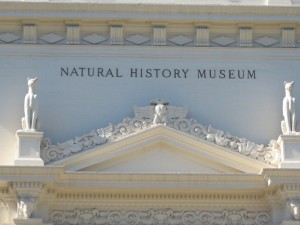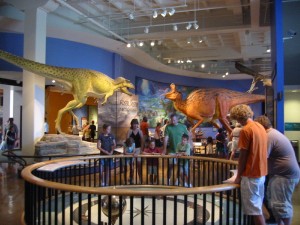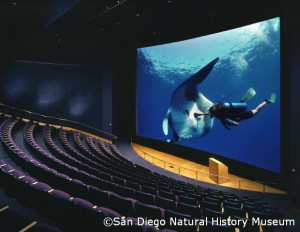San Diego Natural History Museum
by TourGuideTimLocation: Balboa Park (3 Miles Northeast of Downtown San Diego)
Open Daily: 10AM – 5PM; Closed Thanksgiving and Christmas
Cost: $17 ($11 for Kids ages 3-12 and $15 for Seniors 62+)
Features: Dinosaur and Mastodon Artifacts; Over 8.2 Million Artifacts in all; World Class Visiting Exhibitions; Giant Movie Screen for Enjoying Nature Films.
 San Diego Natural History Museum Highlights: San Diego’s Natural History Museum is the third oldest scientific institution west of the Mississippi River. Over the years, it has collected over 8.2 million artifacts. It offers one of the best collections of prehistoric artifacts ranging from the age of the dinosaurs to the time of the mastodons due to the rich history of fossils found in the surrounding area. The Museum generally attracts top quality exhibitions that only visit a few museums throughout the country. It also offers a state-of-the-art theater showing films on nature.
San Diego Natural History Museum Highlights: San Diego’s Natural History Museum is the third oldest scientific institution west of the Mississippi River. Over the years, it has collected over 8.2 million artifacts. It offers one of the best collections of prehistoric artifacts ranging from the age of the dinosaurs to the time of the mastodons due to the rich history of fossils found in the surrounding area. The Museum generally attracts top quality exhibitions that only visit a few museums throughout the country. It also offers a state-of-the-art theater showing films on nature.
When to Visit the Natural History Museum
- Admission on the first Tuesday of every month is free to San Diego County residents. If you want to avoid the crowds, it is best to avoid this day, especially during the summer months. Strollers are not allowed into the building on these days.
- The least crowded times are generally on Mondays and Fridays during the school year, between September and May. School groups are frequent visitors of the Museum, especially on Tuesday through Thursday mornings.
What to Expect
- Consider setting aside at least four hours to enjoy the museum and a Giant Screen movie. You can certainly keep yourself busy for the better part of the day with the exhibits and movies at this natural history museum. For those with disabilities, the Natural History Museum provides easy access elevators on the northwest side of the building. You can find more helpful information online.
- There are five floors of exhibit space starting at the Lower Level and going up to Level 4.
- If you enter from the parking lot area on the north side of the building, you will be on Level 1. If you enter from the pedestrian mall on the south side of the building, you will be on Level 2. If you enter from the pedestrian mall, make a point to exit out the opposite side of the building on Level 1 if you want to see a very large Moreton Bay Fig Tree that has a part of its intricate root system above ground.
- You will spend most of your time on Level 2 with the Fossil Mysteries permanent exhibition and generally one other visiting exhibition.
- The exhibit areas on Levels 3 and 4 only consist of hallways that circle around an open four story atrium in the middle of the building. The hallways include traveling exhibits that show splendid photographs of nature.
- Level 1 includes the movie theater, museum store, cafe, and a smaller exhibit area in the Discovery Center. Don’t Miss This: When you walk out of the Discovery Center at the north end of level 1, you will tend to skip right through the side of a small hallway and out to the main congregation area at the bottom of the four-story atrium. Before rushing out to the atrium, look on the hallway walls to see topographical maps of San Diego and California. These large maps will show you the diverse topography of the the West Coast. It will give you an appreciation on why so many people who love the outdoors find their way to California to enjoy the variety of mountains, deserts, canyons, and ocean. This topography allows those living on the coast to play on the beach under warm sunny skies and then take an hour’s drive into the mountains to play in the snow. Even more dramatically, you can take an aerial tram from the desert floor near Palm Springs where it is over 100 degrees and 15 minutes later be standing in snow. (If you want to do this, it’s best to try it in May or June when the desert is heating up but the mountain snow still lingers around.)
- The Lower Level also hosts a traveling exhibition but is smaller than Levels 1 and 2.
- No Smoking is allowed in or around the Natural History Museum.
 Dinosaur and Mastodon Exhibition – Southern California and the nearby Baja Mexico Peninsula offer a rich history of fossils from prehistoric dinosaurs and mastodons. The artifacts in this exhibition cover over 75 million years of history from the Cretaceous Period, which included dinosaurs through the Pleistocene Epoch, which included mastodons. The Museum takes you through the natural progression of natural history between these two periods describing changes in animal species, climate, and the Earth’s tectonic plates. Most of the fossils were found in this region, which offers both land based and ocean based creatures. The Museum offers history lovers a great online guide with in-depth details about these fossils. At the 2nd Floor entrance, you will see a large interactive globe where you can watch how Earth has evolved over millions of years and how it will continue to evolve in the millions of years ahead. If there is a large crowd around this exhibit, you will see a similar interactive exhibit on a flat screen TV, just a short walk down the hallway on your right in the Fossil Mysteries Exhibition area.
Dinosaur and Mastodon Exhibition – Southern California and the nearby Baja Mexico Peninsula offer a rich history of fossils from prehistoric dinosaurs and mastodons. The artifacts in this exhibition cover over 75 million years of history from the Cretaceous Period, which included dinosaurs through the Pleistocene Epoch, which included mastodons. The Museum takes you through the natural progression of natural history between these two periods describing changes in animal species, climate, and the Earth’s tectonic plates. Most of the fossils were found in this region, which offers both land based and ocean based creatures. The Museum offers history lovers a great online guide with in-depth details about these fossils. At the 2nd Floor entrance, you will see a large interactive globe where you can watch how Earth has evolved over millions of years and how it will continue to evolve in the millions of years ahead. If there is a large crowd around this exhibit, you will see a similar interactive exhibit on a flat screen TV, just a short walk down the hallway on your right in the Fossil Mysteries Exhibition area.
Visiting Exhibitions – The San Diego Natural History Museum hosts several exhibitions throughout the year. You will often find about four exhibitions at any one time, which are on display anywhere from three months to a year. Past exhibitions have included the most comprehensive exhibition of the Dead Sea Scrolls ever assembled and A Day in Pompeii, which was restricted to touring only four museums nationwide. Learn more about all of the current exhibits and take a look at upcoming exhibits.
Giant Screen Movies – The Giant Screen Theater generally offers two “Discovery Channel” type movies about our natural environment throughout the day. These movies start at the top of each hour on a rotating basis. Movies are about 45 minutes long and are included with general admission. The Giant Screen Theater at the San Diego Natural History Museum seats 300 and uses state-of-the-art acoustics and technology.
 Lectures, Programs, and Tours – The staff of the Natural History Museum, which includes several Ph.D’s, has a world of knowledge to share with those who want to learn more about our natural history. You can attend free evening lectures or sign-up for a full semester of classes. Topics range from geology to paleontology. You can also go on a wide variety of day trips or join overnight expeditions. This is your opportunity to kayak with pelicans and sea lions or learn how to take photographs of nature. Check out the full list of programs offered for visitors of all ages. If you live outside of San Diego, don’t worry, you can listen to some of the lectures online.
Lectures, Programs, and Tours – The staff of the Natural History Museum, which includes several Ph.D’s, has a world of knowledge to share with those who want to learn more about our natural history. You can attend free evening lectures or sign-up for a full semester of classes. Topics range from geology to paleontology. You can also go on a wide variety of day trips or join overnight expeditions. This is your opportunity to kayak with pelicans and sea lions or learn how to take photographs of nature. Check out the full list of programs offered for visitors of all ages. If you live outside of San Diego, don’t worry, you can listen to some of the lectures online.
Food – Dinosaur Cafe is located in the 1st floor lobby of the Natural History Museum and offers a small selection of food options, including pre-made sandwiches. Note that it is closed on Mondays and closes at 3PM on the other days of the week. The nearby Village Grill is another option. It offers hamburgers, sandwiches and other hot foods with outdoor seating. You will see it if you head out of the 1st Floor Entrance and walk to your left around the large Moreton Bay Fig Tree.
You will find additional cafes near the entrances of some of the other museums in Balboa Park, including the Galileo Cafe outside of the Science Museum just across the Pedestrian Promenade. (Exit through the 2nd Floor Entrance to reach the Pedestrian Promenade.) If you are looking for something more than what is offered in a cafe, Balboa Park’s Prado Restaurant is more of an upscale full service restaurant. You can read more about the food options on the Balboa Park web site.
Information on Visiting the San Diego Natural History Museum
Admission Prices: (Costs are Approximate)
- Parking is Free
- Standard Fee is $17; ($11 for Kids ages 3-12 and $15 for Seniors 62 and over.)
- Active Military Members and Students with I.D. can gain access for $12.
- General admission includes access to movies in the Giant Screen Theater.
- Memberships are available. They are several membership levels to choose from. The Family Memberships are a great bargain if you plan to visit more than once during the year.
- General Admission is Free for San Diego County residents and for Active Military & their families on the 1st Tuesday of each month.
- Passport to Balboa Park – Pay one low price for a Pass that will allow you one entry into each of thirteen participating Balboa Park Museums. You have seven days to use the Park Pass once you begin using it. For an additional fee, you can add a discounted San Diego Zoo Best Value ticket. Also note, the Passport to Balboa Park Pass allows you to watch an IMAX movie at the Science Center. Passport to Balboa Park tickets can be purchased online or at participating attractions, except at the Zoo.
Directions from Google Maps to 1788 El Prado in San Diego, CA 92101
Parking – There are two parking lots adjacent to the Natural History Museum. Both can be accessed just after you turn on to Village Place. If these lots are full, the next best option is to find street parking or head south on Park Boulevard towards downtown and take a left on Presidents Way. It will take you 15 minutes or so to walk to the Museum. You can also take the free Balboa Park Tram, which starts near the end of the Presidents Way driveway. Get off at the Prado stop near the Balboa Park Information Center and walk a few minutes down the Pedestrian Mall to the Museum.
Traffic – Unless there is a major event at Balboa Park, which occurs a few times during the year, getting in and out of the Natural History Museum is relatively easy using Park Boulevard. If you approach Balboa Park using southbound SR-163, traffic occasionally backs up a little over a mile before reaching the Park Boulevard Exit, which is the same exit for the I-5 northbound. However, the delay will only take a few extra minutes. Likewise, if you are planning to get on SR-163 northbound after leaving the Natural History Museum, plan on a short delay during the mid and late afternoon hours as a few entrance ramps merge together before reaching the highway. (Learn how to get the latest traffic updates.)
Transit – Buses serving Balboa Park drop passengers off on Park Boulevard near the Reuben H. Fleet Science Center and the San Diego Museum of Natural History. The stop is underneath a pedestrian bridge, which you can take to reach the Museum. (See San Diego Transit Information for the downtown transit map, which includes Balboa Park, and information for the online Transit Planner.)
You can also get off the bus at Presidents Way to catch the Free Balboa Park Tram. The Tram starts at the end of the driveway, on the east side of Presidents Way and circulates every 10 minutes from here to the main circle at the Prado stop, near the Balboa Park Information Center. The Tram runs from 8:30AM – 6PM daily with extended hours during the summer and special occasions.
Balboa Park Map – The map shows a listing of all Balboa Park Museums, attractions, bus and tram stops, and places to eat. You should also print out the Balboa Park Tram Map from the City of San Diego. It is not as detailed but is helpful because it includes names on each of the buildings. With the other map, you need to use a map key to find the name of a building.
Find More Attractions with Similar Themes or Location: *San Diego Tours & Sightseeing*, *Top San Diego Museums*, Balboa Park, Kids Attractions & Activities |

 Print the San Diego Map
Print the San Diego Map Print the La Jolla Map
Print the La Jolla Map




 San Diego Attractions on Twitter
San Diego Attractions on Twitter